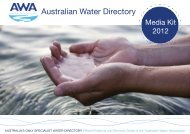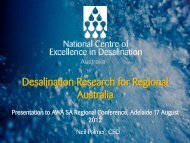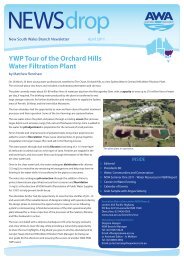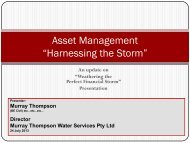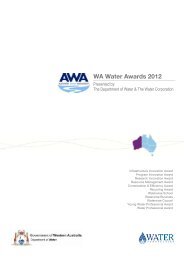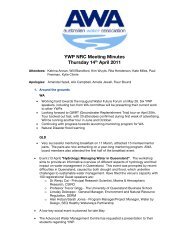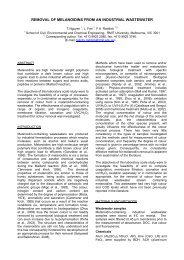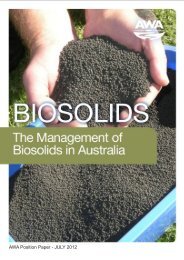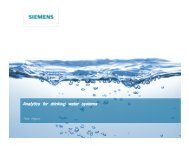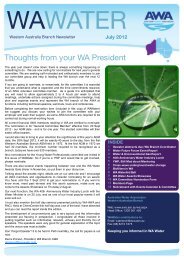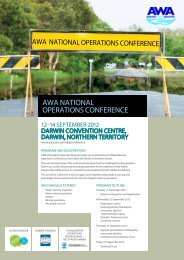National Water Skills Audit - Australian Water Association
National Water Skills Audit - Australian Water Association
National Water Skills Audit - Australian Water Association
- No tags were found...
Create successful ePaper yourself
Turn your PDF publications into a flip-book with our unique Google optimized e-Paper software.
activities such as offering scholarships, supervising/collaborating with postgraduate students and providingresearch support also occur infrequently.Table 3.4 illustrates the types and level of engagementbetween industry and university. Engagement canoccur at various levels with a parallel investment, thatis, the greater the benefits the higher the investment.Traditionally engagement has focused on awarenessraisingactivities including information sessions, careersevents and hiring.Relevant <strong>Australian</strong> GovernmentInitiativesTable 3.5 presents an overview of the policies, strategiesand programmes that are most relevant to this audit.These are current as at May 2008, though it is notedthat this is a rapidly changing environment in the earlymonths of a new Commonwealth Government.The Commonwealth of Australia’s 2007 initiativeRealising our potential, is a comprehensive programmeof reforms to the entire education sector. It involves aninvestment of $3.5 billion over four years – $1.7 billion foruniversities, $222 million to improve access to tertiaryeducation, $638 million for vocational education, $843million for schools and the establishment of a HigherEducation Endowment Fund (HEEF) with initial capital of$5 billion.This programme of reform builds on other policies suchas Skilling Australia for the Future which is a tripartiteapproach for up-skilling existing workers and jobseekersthat represents a change of focus from provider(Registered Training Organisations’s) to industry demanddriven places. Together with reform of the educationindustry, the overall aim is to halve the proportion of<strong>Australian</strong>s without qualifications at Certificate III andabove and to double the number of completions ofhigher qualification (Diploma and Advanced Diploma) forthose between 20–64 years of age.Central to this policy is the Productivity Places Programwhich targets training for priority occupations inindustries identified as experiencing skills shortages.These priority occupations are listed in the <strong>National</strong> <strong>Skills</strong>Need List (not specifically identifying the water sector)and are derived from one-off surveys of employers as‘difficult to fill occupations’ or are identified as being inshortage from the SERA survey series, undertaken byDEEWR and updated every six months. However, thisindicator is useful for job seekers but does not reflectthe up-skilling requirements of the existing workforce orthe existence of new or evolving job roles.A total of 450,000 new training places will be providedthrough the Productivity Places Program, 275,000of which will be for training existing staff, and thebalance of 175,000 targeted at jobseekers. Of the‘existing worker’ places, 45,000 will be for <strong>Australian</strong>apprenticeships and, of the ‘job seeker’ places, 20,000will be for <strong>Australian</strong> Apprenticeships. The majority ofthese places (about 90 per cent) will be at Certificate IIIlevel or higher to ensure that skills demands are met forindustry.These places will be filled over the next four years inthree phases, as follows. Phase 1 will provide 20,000 jobseeker places in RTO’s from 1 April 2008 (Certificate IIand III levels); Phase 2 will provide additional job seekerplaces as well as places for existing workers from1July 2008 – December 2008; and Phase 3 will provideexisting workers and job seeker places from 1 January2009 and beyond. The delivery models will be refinedbased on the lessons learnt in the initial two phases andapplied to the third phase and into the future.There have been a number of commitments aiming torectify issues identified in the education and trainingsector. Most recently, in 2008, <strong>Skills</strong> Australia wasestablished as an independent statutory body and isgoverned by the <strong>Skills</strong> Australia Act 2008. Its function isto provide advice to the <strong>Australian</strong> Government to assisttargeting of skills and workforce development throughanalysis of skills requirements of industry and will workwith existing Industry <strong>Skills</strong> Councils. This has providedthe VET sector with a clear set of guiding principles forbuilding on linkages with industry. However, universitiesdo not have a framework for consultation with industryand, hence, there remain many barriers that impactcollaboration between the two.As a response to these new policies and programmes,GSA’s role has been expanded to that of broker forcompetitive applications for the additional trainingplaces outlined in Table 3.5. However, it is not as simpleas defining priority occupations and filling training oreducation places to alleviate the skills shortage. Thereare a number of other factors in play that are impactingon the water industry and the skill levels of theworkforce that may make it difficult to achieve the skilllevel required.BarriersIn 2007, GSA conducted an environmental scan ofthe range of current issues within the scope of GSAoperations including the core water sector, which isvariably reported as having between about 20,000and 60,000 employees, plus contractors and productsupply chain employees, depending on how job rolesare defined. The report identified a number of additionalissues with attracting and retaining staff that areexperienced by the water sector, as discussed below.Potential reasons for the general lack of interest instudying engineering and some sciences and otherICE WaRM • <strong>National</strong> <strong>Skills</strong> <strong>Audit</strong> (Phase One) Report 15



